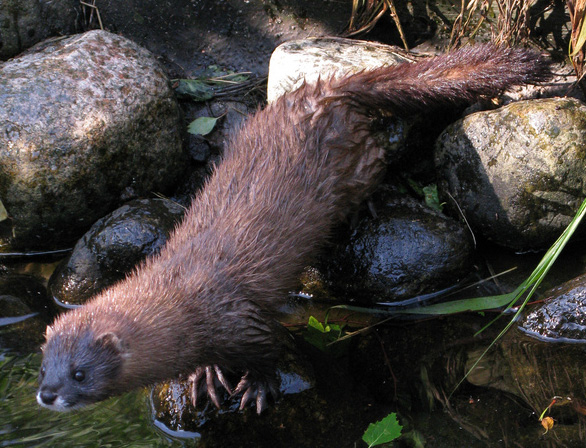
Species of the week # 14 – european mink
The mink, now known only by name as fur coat, is a European wild animal that can currently only be preserved by the European conservation breeding programme. The American mink, which is still bred in fur farms, is a species of its own and cannot be crossbred with it.
| Distribution status | Extinct throughout Germany |
| Residual deposits | Resettlement project in Saarland near Lebach |
| Last sighting in Rhineland-Palatinate | unknown,probably beginning of the 20th century. |
| Habitat | Near-natural banks of running and still waters |
| Threats | drainage of wetlands |
Mink are strict loners and each occupies its own territory. Relatively little is known about the size of such territories, but it is known that they can be several kilometres long on rivers and that the animals are rarely more than 150 metres from the shore.
The mink’s diet is varied: the spectrum includes small mammals (e.g. mice), smaller fish, amphibians, birds, water insects and crabs. Access to water is also important in winter. It is precisely then that minks, for example, often feed on frogs, which are in winter rigidity and are captured while diving at the bottom of the water. For this purpose they independently keep holes in the ice open when a closed ice cover forms on the water.
The original distribution area of the mink stretched from eastern Spain to the Urals and from central Finland to the Black Sea. Today, instead of this large area, only small, isolated populations exist in western France, northern Spain, Belarus and the Danube delta of Romania, in addition to a larger population in Russia. A reintroduction project on the Ill River in Saarland is showing the first small successful releases of minks. However, the population is still considered unstable.
Politically necessary:
– Conservation and rewetting of wetlands
– Improving water quality in streams, floodplains and lakes
– Resettlement projects
– Time limit for water maintenance measures in settlement areas of European
Picture: By Immortel – European mink is curiousUploaded by Mariomassone, CC BY 2.0, https://commons.wikimedia.org/w/index.php?curid=37679790
